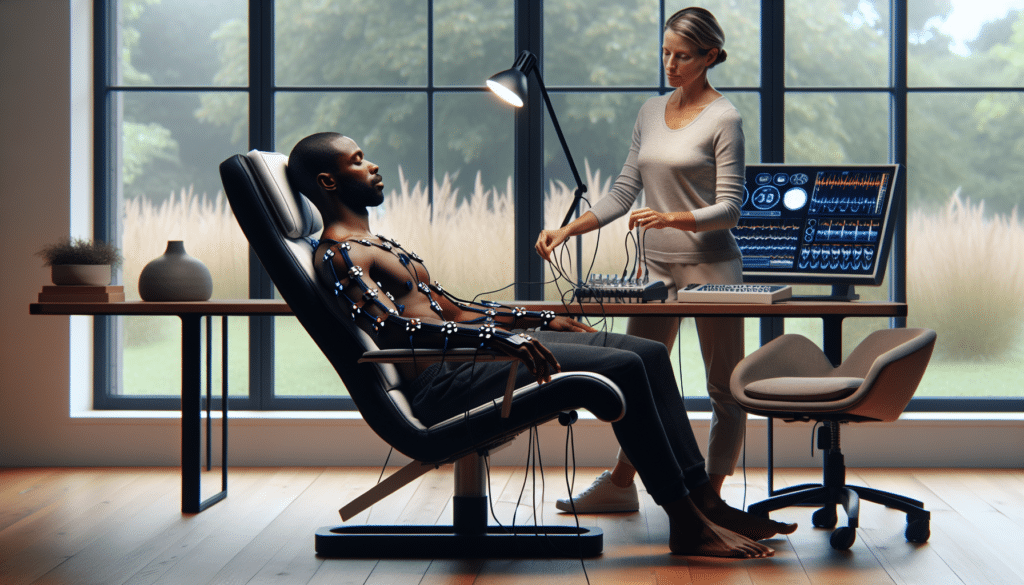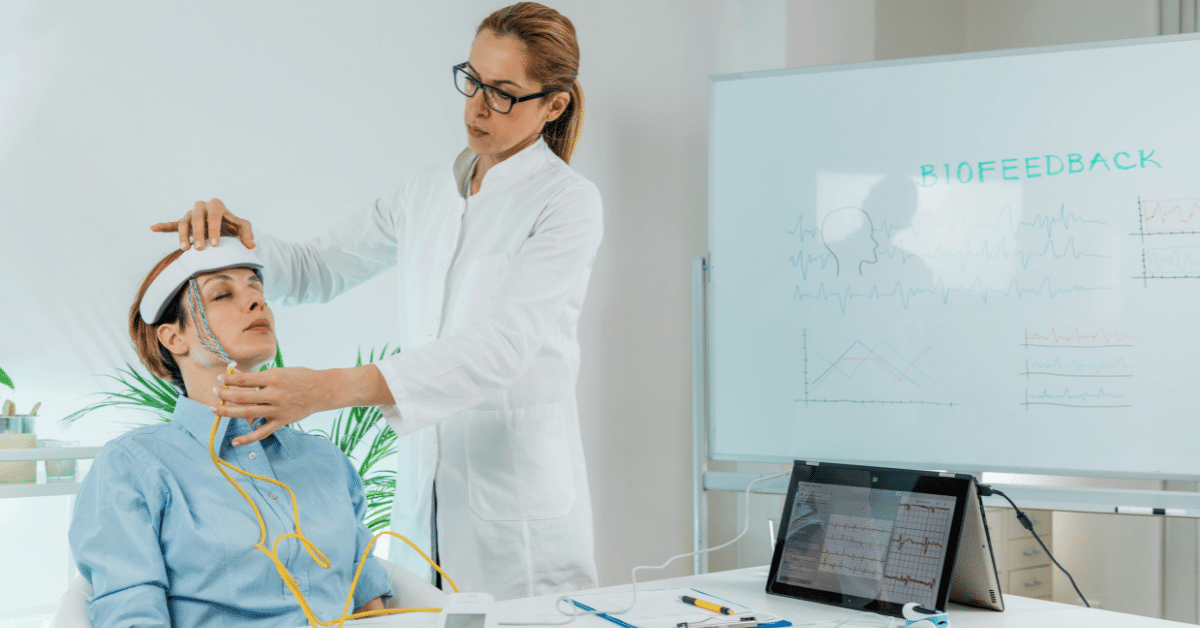La terapia de biorretroalimentación está ganando atención por su capacidad para ayudar a las personas a controlar funciones corporales como la frecuencia cardíaca y el estrés. 1En este blog, le explicaremos cómo funciona, sus beneficios y usos cotidianos para ayudarle a gestionar mejor su salud.
¿Qué es la terapia de biorretroalimentación y cómo funciona?
La terapia de biorretroalimentación implica el uso de dispositivos de monitoreo electrónico para entrenar a las personas a controlar procesos corporales, como la frecuencia cardíaca y la tensión muscular, que normalmente son involuntarios. Esta terapia ayuda a controlar el estrés, el dolor y otras afecciones mediante la enseñanza de técnicas para controlar las reacciones fisiológicas a través de retroalimentación en tiempo real.
This blog is part of a series on “Técnicas de relajación.” The next blog is about entrenamiento autógeno.
Aspectos clave de la terapia de biorretroalimentación
- Definición: La terapia de biorretroalimentación utiliza dispositivos de monitoreo para enseñar a controlar las funciones corporales involuntarias.
- Técnicas: Incluye métodos como monitorización de la frecuencia cardíaca y de las ondas cerebrales para el manejo del estrés y del dolor.
- Beneficios: Ofrece un mejor manejo de la ansiedad, el dolor crónico y otras afecciones relacionadas con el estrés.
- Aplicaciones: Ampliamente utilizado tanto en entornos clínicos como domésticos para mejorar la salud física y mental.
- Aprendiendo: Los pacientes aprenden a modificar su actividad fisiológica a través de retroalimentación en tiempo real, obteniendo un mejor control de su salud.
- Seguridad: Un método no invasivo y seguro con alta implicación y control del paciente.
¿Qué es la terapia de biorretroalimentación?
La terapia de biorretroalimentación le permite controlar funciones corporales involuntarias, como la frecuencia cardíaca y la tensión muscular. Es un método no invasivo en el que los sensores rastrean cómo reacciona su cuerpo a diferentes condiciones. Esta terapia le ayuda a reconocer los desencadenantes del estrés y la ansiedad, lo que le permite reaccionar mediante técnicas de relajación.
Se ha vuelto popular en la medicina alternativa por su papel en el manejo del dolor crónico y el estrés sin medicación. Los pacientes pueden mejorar su salud mental y física al aprender a controlar estas funciones. Las sesiones de biorretroalimentación suelen implicar retroalimentación de datos en tiempo real que ayuda a enseñar relajación y control.
Tipos de biorretroalimentación y sus funciones específicas
La biorretroalimentación varía según el tipo de sensor utilizado y la función corporal que monitorea. Los tipos más comunes incluyen la biorretroalimentación EEG, que monitorea las ondas cerebrales y se emplea a menudo para tratar el TDAH y otras afecciones relacionadas con el cerebro. La biorretroalimentación de la variabilidad de la frecuencia cardíaca ayuda a controlar la frecuencia cardíaca y es útil para controlar el estrés y la ansiedad.
Otro tipo, la biorretroalimentación EMG, se centra en la actividad muscular y es útil para tratar afecciones relacionadas con la tensión muscular y los trastornos del movimiento. Por su parte, la biorretroalimentación térmica mide la temperatura de la piel, lo que puede indicar niveles de estrés y ayudar a reducirlos.
| Tipo de biorretroalimentación | Función monitoreada | Usos comunes |
|---|---|---|
| Biorretroalimentación EEG (Neurofeedback) | Ondas cerebrales | TDAH, Trastornos del sueño, Reducción del estrés |
| Biorretroalimentación de variabilidad de la frecuencia cardíaca | Frecuencia cardíaca | Ansiedad, manejo del estrés, afecciones cardíacas |
| Biorretroalimentación EMG | Actividad muscular | Rehabilitación muscular, Dolor crónico, Entrenamiento deportivo |
| Biorretroalimentación térmica | Temperatura de la piel | Reducción del estrés, prevención de la migraña |
| Biorretroalimentación respiratoria | Patrones de respiración | Asma, ansiedad, trastornos respiratorios |
Cada tipo de biorretroalimentación se centra en problemas de salud específicos y ofrece opciones de terapia personalizadas. Esta especialización ayuda a garantizar que se utilice la técnica adecuada para la afección correcta, maximizando así la eficacia de la terapia.
Cómo funciona el entrenamiento de biorretroalimentación
En una sesión de biorretroalimentación, los terapeutas colocan sensores en el cuerpo para medir respuestas como la frecuencia cardíaca, la respiración y la temperatura de la piel. Esta sesión puede arrojar luz sobre cómo responde el cuerpo al estrés o a las señales de relajación. Es como tener una conversación con las señales sutiles del cuerpo.
El terapeuta le guiará a través de ejercicios que le ayudarán a controlar estas respuestas. Por ejemplo, se pueden utilizar técnicas de respiración para calmarse o reducir la frecuencia cardíaca. A medida que vea la retroalimentación en tiempo real, será más fácil comprender y manipular las respuestas de su cuerpo.

Esta formación es fundamental para que los pacientes aprendan estrategias eficaces de tratamiento de sus síntomas, ya sea ansiedad, dolor crónico o incluso tensión muscular. Estas técnicas pueden volverse algo natural con la práctica, lo que permite un mejor control de la salud.
Eficacia del biofeedback en el tratamiento de problemas de salud
Los estudios han demostrado que la biorretroalimentación puede reducir eficazmente los síntomas de diversas afecciones. En el caso del dolor crónico, esta terapia puede disminuir la intensidad y la frecuencia del dolor. También reduce eficazmente la ansiedad y el estrés al ayudar a las personas a aprender técnicas de relajación.
La biorretroalimentación también se ha utilizado para tratar la hipertensión arterial y los dolores de cabeza, lo que supone un enfoque no farmacológico para controlar estas afecciones. Los mecanismos de retroalimentación ayudan a los pacientes a comprender y controlar sus respuestas fisiológicas a los factores estresantes.
El éxito de la biorretroalimentación depende de la práctica constante y de la aplicación de las técnicas aprendidas durante las sesiones. Muchas personas descubren que el uso regular de la biorretroalimentación puede mejorar la salud general y reducir la necesidad de tomar medicamentos.
Usos del biofeedback en la gestión de la salud cotidiana
La biorretroalimentación no es solo para entornos clínicos; se puede incorporar a la vida diaria. Las personas utilizan técnicas de biorretroalimentación en el hogar para controlar el estrés y la ansiedad cotidianos. Se pueden utilizar dispositivos sencillos para practicar estas técnicas., mejorando la relajación y la salud general.
La práctica regular de biorretroalimentación también puede ayudar a mejorar la calidad del sueño y a controlar los trastornos digestivos. Te enseña a controlar respuestas como la tensión muscular o la frecuencia cardíaca, lo que puede ser especialmente útil antes de situaciones estresantes o para controlar enfermedades crónicas.
Esta terapia se adapta bien a un enfoque de salud holístico y complementa otras prácticas de salud como el ejercicio y la meditación. La biorretroalimentación ayuda a regular las respuestas del cuerpo, mejorando en gran medida la capacidad de mantener el equilibrio y la salud.
Pensamientos personales
Explorar la terapia de biorretroalimentación me ha ayudado a controlar el estrés. Al monitorear las señales fisiológicas, aprendí a relajarme de manera efectiva y a ver resultados en tiempo real que refuerzan mi progreso.
Este método me ha proporcionado una herramienta práctica para controlar mi respuesta al estrés, ayudándome a aplicar técnicas científicas a mi vida cotidiana. La diferencia es palpable y recomiendo que prueben la biorretroalimentación a quienes tengan problemas similares.
Preguntas frecuentes
¿Qué condiciones trata la terapia de biorretroalimentación?
La terapia de biorretroalimentación se utiliza para tratar una variedad de problemas de salud, incluidos el estrés, la ansiedad, el dolor crónico, la hipertensión y las migrañas, ofreciendo un método de terapia alternativo a los tratamientos tradicionales.
¿Cómo funciona el equipo de biorretroalimentación?
Los equipos de biorretroalimentación utilizan sensores adheridos al cuerpo para medir la actividad fisiológica, como la frecuencia cardíaca, la tensión muscular y las ondas cerebrales. Estos datos se transmiten al paciente en tiempo real, lo que le permite aprender a realizar cambios sutiles en las respuestas de su cuerpo y controlar eficazmente los síntomas.
¿Cuáles son los beneficios de someterse a una terapia de biorretroalimentación?
La terapia de biorretroalimentación ofrece múltiples beneficios, entre ellos, un mejor control de los procesos fisiológicos involuntarios, alivio del dolor, reducción del estrés y una mayor relajación. Las sesiones regulares pueden mejorar la salud mental y física al enseñar técnicas que controlan las respuestas corporales relacionadas con el estrés y la ansiedad.
¿Se considera segura la terapia de biorretroalimentación?
Sí, la biorretroalimentación es generalmente segura. Es un tratamiento no invasivo con riesgos mínimos. La biorretroalimentación suele recomendarse a personas que buscan métodos no farmacéuticos para tratar sus problemas de salud. Sin embargo, es importante realizar sesiones con un profesional de biorretroalimentación calificado para garantizar la seguridad y la eficacia.
¿Puede utilizarse la terapia de biorretroalimentación como tratamiento independiente?
La terapia de biorretroalimentación puede ser un tratamiento independiente eficaz para ciertas afecciones, como la reducción del estrés y el reentrenamiento muscular. Sin embargo, a menudo se utiliza junto con otros tratamientos, como medicamentos y fisioterapia, para maximizar los beneficios para la salud y tratar problemas de salud más complejos.




